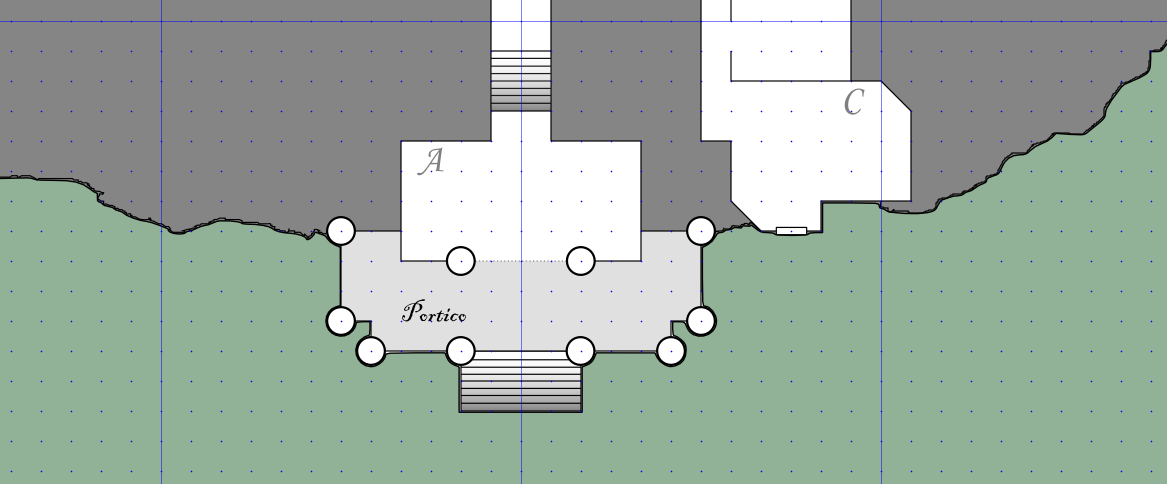It’s been a couple of weeks since I updated everyone on the status of our Dungeons & Dragons game. Not to worry, though—there’s been plenty of action to generate both blog posts and episode content. Plus, we’re trying something new by not missing sessions, and I’m pleased to report that this seems to be working surprisingly well!
But seriously: Last week, the party wrapped up the first dungeon crawl of the campaign. This was kind of a major milestone for our gaming group, on both sides of the virtual GM’s screen. My wife had never actually explored a proper ‘dungeon’ before, since she’s relatively new to gaming. I’d put maps together for the Savage Shadowrun we played a while back, but those were mostly floor plans I’d filed the serial numbers off and turned into heist scenarios; this was a properly-gridded dungeon, which the players had no foreknowledge of, and that was a first for our group. And for myself, this was a bit of a personal milestone: My previous D&D game was a terrible Eberron game, where I’d focused so heavily on making pretty maps that I completely neglected to put together a coherent plot. So just by virtue of entering a dungeon at all, we were off to a good start.
Good thing, too.
Recap

As mentioned previously, the shipwrecked and battered colonists had taken refuge at the entrance of a large structure built into the shore-ward cliffs to defend themselves against further sahuagin attacks. I mentioned a few things that the colonists were short on and in immediate need of, making sure to include fresh water in that list for … well, you’ll see why.
The governor—one Baroness Hester Warwick—asked the player characters to explore the structure and make sure there weren’t any nasty surprises lurking inside, behind the colonists. They waited until morning, loaded up on supplies—in particular, Garm (the human fighter) grabbed a sturdy club and Lambert (the human cleric) cast a light spell on it to act as a torch. A few other light spells were cast—it’s a cantrip in 5th Edition, so any party with a cleric should never be hurting for light in a dungeon—and in they went.
The vestibule (A) and long hallway were quite weather-worn, as you’d expect from an ancient structure carved from sandstone next to a hurricane-prone ocean. Few details were gleaned from the long hallway, though some evidence of bas-relief carvings remained and a few nature scenes were legible. Centuries of sand and natural debris, blown up the stairs by storms over time, made the entrance hallways messy, but passable. At the other end of this hallway stood chamber (B), apparently a sort of ‘hub’ for traffic, with a balcony, stairs and several exits.
The players quickly explored the space the northeast of this chamber, revealing it to be an empty store-room devoid of everything except pottery shards. They then went southeast to (D), which turned up a lot of trash, oversized snake pellets (uh-oh), oversized snake skins (uh-oh), and a rather prettily-carved bone bracelet (uh… okay?) which Aster (the half-elven thief) claimed for her own. These rooms appeared to have once been very plain living quarters, with a slab to sleep on—rather like cells. The larger room (C) right at the cliff face, however, had a window and seemed rather nicer, except for the giant poisonous snake. This struck at Aster and knocked her unconscious, but Garm and Lambert quickly dealt with it, and Lambert’s cure wounds put Aster back on her feet immediately.
Naturally, the next step was to dump the giant snake out the window onto the colonists below, which occasioned some comment later and some screaming almost immediately.
Heading back, the party crossed over to (E), where Lambert began to get a vague feeling that he’d been somewhere like this before. Nothing immediately came to mind; but this room, with a raised dais, bookshelves (whose contents had long since rotted away), and stone benches and tables, was the first space that looked reasonably habitable.

Heading up the stairs north of (E), with Aster (and her darkvision) scouting ahead, the characters noticed a flickering glow around the corner. This turned out to be coming from a number of giant fire beetles living in (F). The party made a bit of noise in the hall, which attracted the fire beetles, and what I’d planned to be a sort of centerpiece fight around rough terrain (along with a nasty surprise) turned into a simple matter of luring beetles into the hallway and dealing with them one or two at a time. Garm and Lambert did most of the work, and Aster eventually snuck into (F), climbed some of the large debris (fallen from the ceiling over time) and picked off the last one with her shortbow. She did trigger that “nasty surprise” I mentioned on her way back, but the violet fungus whiffed its surprise attack and was easily dealt with afterwards. The party was covered with bioluminescent goop, but otherwise completely unharmed!
On examining this largest room (F), Lambert could finally hazard a reasonable guess as to what this complex had once been: A monastery of some sort. The rooms below were for visitors, including a nicer room for an occasional VIP, and the gathering room was potentially something like a chapter house. The damp, fungus-covered room the party currently stood in could have been a refectory; and that supposition was strengthened by the discovery of a kitchen in the next room (G). Attached to that through a narrow hallway was a washroom (H), probably used for hot baths and laundry depending on what was needed. (The party found a small, corroded statue of Lisopheth, the goddess of fresh water, in an alcove in this room.) While the way up near (G) and (H) was blocked by dirt and limbs, water and a breeze were clearly leaking through, indicating that this passageway probably lead outside to the top of the cliff at one time.
East of the refectory was a spiral staircase leading down; another ramp leading up into darkness; and a pair of rooms (I) and (J) which had apparently once been dormitories. Lambert and Garm estimated that, judging by the space and scattered remnants of simple bedframes, there were probably no more than a dozen monks in this space at any given time. A definite stink filled this space, and Aster discovered a small iron dagger with a bird’s beak as its pommel next to a variety of unrecognizable bones and a few large, black feathers. The three giant rats in (J) explained the stink and remnants. Once again, the party dealt with the problem rather cleverly: Garm and Lambert marched rather noisily around to the west side of (J), drawing their attention so Aster could sneak up on the rats and dispatch them from the northern entrance to the room. It worked so well that after the first two rats were down, I stopped combat, narrating the third rat’s demise rather than wasting time rolling. A search afterwards turned up a small box of unrecognizable and likely ancient gold coins stuffed into a crack in the wall.
At this point, we wrapped up the session, and it turned out everyone had rather conveniently just hit level 2. (No, I didn’t actually plan that—it was providential.) The players decided their characters would take a short rest in the hallway north of (I), to get away from the fetid stench of the giant rats’ nest. A few Hit Dice were spent to heal up, and in between sessions everyone did the minimal book-keeping required to level up in 5th Edition.
After their rest, the party decided to go down the spiral staircase to the east. I hadn’t mapped this part of the dungeon, partly because I wanted the players’ imaginations to fill in, partly because there wasn’t going to be any combat down here, and—well, partly because I’d run out of time prepping for the session. A flooded hallway with flickering white light shining through the semi-salt water confronted the party. Garm took some of Aster’s rope, a piton, and his club and dove in, using the weight of his chainmail to walk as far as he could before having to turn around and return for air. He’d just about reached his limit—a very impressive thirty feet underwater in heavy armor—when he felt steps and was able to climb up into surprisingly fresh air beyond. After tacking down the rope, the other two could cross more easily, and everyone made it through that obstacle unscathed.
The light turned out to be coming from a continual flame spell over a large arched doorway; but of more immediate interest to a party of treasure-hunting PCs was the storeroom next to them. This turned out to contain an old stone chest filled with copper, gold, silver, a magical gem, an obviously magical cloak, and a magical rod of some sort. (More on these later.)
The larger chamber, oddly enough, contained nothing but a large pool of fresh water filled by a spring flowing from a crack in the wall. The party was just about to leave when a naiad (a water fey, rather like a dryad) rose up from the pool. She answered a few questions—most notably, she confirmed that this had been a monastery for worshipers of powerful fey, whom she also served and who had bound her to this pool a very long time before. (Turns out fey aren’t good at keeping time, especially when they can’t see the sun, moon or stars.) She confirmed that the flooded hallway would drain over the next day or so, and agreed to let the colonists draw water from her pool on three conditions: First, that the colonists did not defile or dirty her pool; second, that the party deal with the trapped spirit of a monk trapped in undeath within the monastery; and third, that in a year and a day the three party members would return to perform a service for the naiad. This last was a bit worrisome—no one clever likes to owe a fey creature favors or services—but given how desperately the colony needed fresh water, the party agreed.
Back upstairs, the party carefully approached the final room of the monastery, which turned out to be the abbot’s quarters. This too wasn’t mapped, because I’d (again) not had time, but also because leaving it a bit vague made this part rather creepier. The room turned out to have a private chapel of sorts attached to it, and the skeletal remains of the abbot were still on the floor there, where he’d clearly met some sort of violent end. After that discovery, the shadow I’d had lurking in the room, making furtive movements, finally attacked. Unfortunately, its attacks were pretty much ineffective—I just couldn’t roll well, Lambert had just acquired his turn undead class feature after leveling up, and everyone else cleverly used their lights to keep track of the shadow and prevent it from hiding. It only managed one successful attack on Garm before being defeated.
That pretty much wrapped things up—the monastery had been explored, treasure had been found, and an inconvenient but inexhaustible supply of fresh water had been acquired for the colony. The naiad’s spring won’t serve the colony forever, but it definitely solves a major, immediate need. The party also got to keep most of their treasure—taxation is an interesting little wrinkle I threw into this game, and something I’ll have to talk about soon—and the magic items turned out to be an elemental gem of water (which summons a water elemental when smashed), a cloak of the manta ray (which lets its wearer swim easily and breathe underwater), and an immovable rod (a classic D&D item, and one with an infinite variety of uses for a clever group of PCs.) All in all, not bad for two sessions of work!
GM’s Notes
My roleplaying career started with D&D Third Edition, and the wacky old dungeons of earlier editions had been relegated to history by that time. The D&D CRPGs I played before I ever picked up dice—Baldur’s Gate, Neverwinter Nights, and Planescape: Torment—hinted at those just a little bit, but they mostly presented dungeons which fit well into the setting and whose construction mostly made sense. No truly weird features, like White Plume Mountain’s hovering river, no Tomb of Horrors‘s demon mouth of annihilation, nor Undermountain’s … everything. As a result, I’ve always believed a “good” dungeon should have a clear purpose and a sensible history in within its setting, and that fantastic features likewise need to suit the setting and need to exist for reasons which made good sense to their creators. Certainly this ancient, ruined monastery fits that mold; it had an ecosystem of sorts, and its history mattered a great deal (and will hopefully continue to matter going forward.)
On a personal note, I managed to spend minimal time on these maps, and that’s great. I’ve mentioned on the podcast before that my Eberron game failed in part because I spent so much time making pretty maps in MapTool, with all sorts of layers and dynamic lighting and visibility and pretty special effects, that the plot never developed. That didn’t happen this time—hallelujah!—and the game was much improved for it.
I don’t have much else to say about this dungeon crawl, in part because dungeon crawls are sort of their own reward. A good dungeon serves the same purpose as any other location in a RPG—they’re places where the game’s story is developed both procedurally and dramatically. What makes a dungeon crawl special is the challenges—done right, they’re a series of puzzles, whether those be combat-related or not. These encounters were mostly combats, but I hope to change that in the future. (I do tend to struggle with non-combat encounters a bit.)
We likely won’t be doing too many dungeon crawls in this game. There’s too much overworld exploration, colonial social development, and external diplomacy (hint hint!) to do in this game for that. But there will be a few more, and while I’ve got plenty of room to improve, I think I’ve set the bar reasonably high for those future dungeons.





One thought on “Campaign Report 2: The Ancient Monastery”
What’s the geography like where they’re headed? There’s mountains — are these granitic, with clefts and slabs (much harder to dig into but with lots of minerals) or limestone and marble, with fewer gems and minerals but greater possibility for sinkholes and so on? If this is the edge of an uplift region that would account for the cliffs and the water situation.